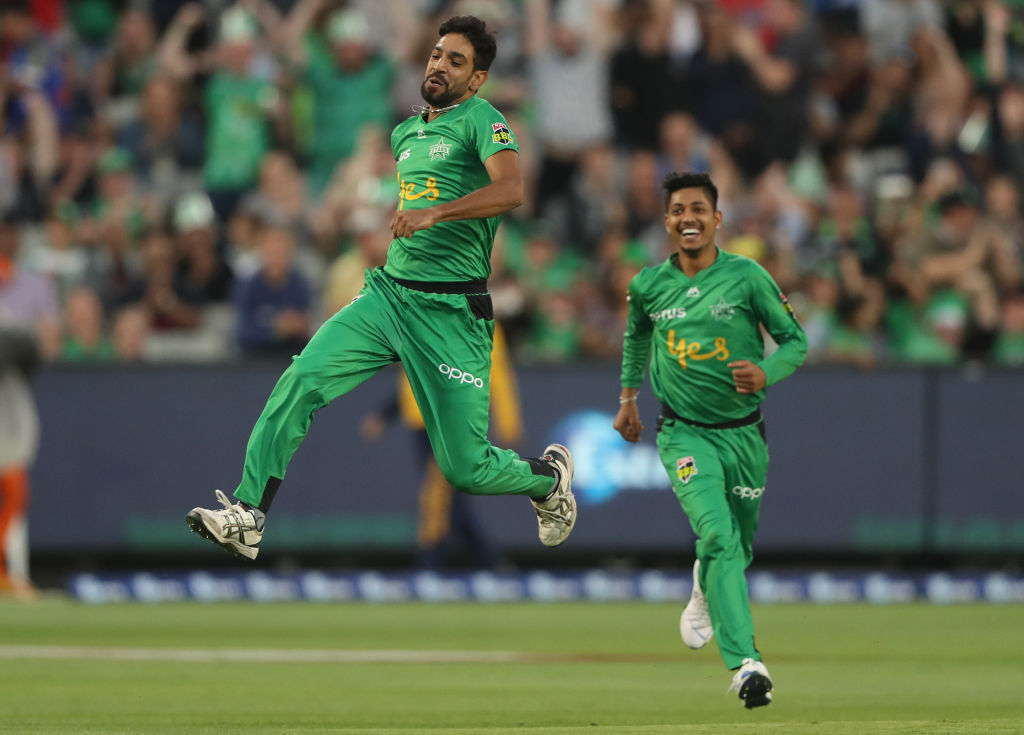Gully Boy Haris Rauf's journey begins with Pakistan

Getty
It is indeed the next edition of rags to riches story, thanks to the 26-year-old Haris Rauf from the city that Pakistan calls home to pace bowlers with Shoaib Akthar the most notable one from Rawalpindi. From tape-ball to wearing the Green and Gold Pakistan jersey, Rauf’s journey just begun.
All life is a journey, not a home; it is a road, not the country. Like every other struggling story, this too began in the Gullies of Rawalpindi, where a young quick was playing with the tennis ball hiding it from his parents. Haris’ journey was excruciating, plaguing due to the lack of confidence shown on the youngster in his early days with the tennis ball. However, all that they could do instead is make him hungry for success, improvement and moreover to drive him towards in breaking the door that would lead him to cricket.
When a 1.7 m pacer walked out amidst all the ‘shor-sharabas’ to play tape-ball cricket in Pakistan, the intent had to be on point from the dot. His first delivery clearly caught the batsman by surprise and gleefully deposited outside the boundary by Khurram Chakwal. His dreams came crashing down before it even started seeing the daylight. However, after that, he slowly caught the batsman by surprise, scaring the batsman mentally, all of this by an unknown commodity in Pakistan’s gully cricket. Slowly, the pacer started getting more people on his side or made the right ‘shor’ to get the attention from the domestic circuit.
Till 2017, the 23-year-old was continuing to top the speed-gun like an employee before a salary-hike. Alongside his friend, the duo went to the open trials at Lahore Qalandar, the first for the two. Until then, faith on a fair trial was miles away from the pacers’ radar, who had faced several dejections at club-level due to favouritism. Gujranwala, September 2017, the gate to the trial and his future seemed to be closed for the good due to his late entry.
“They said, we couldn’t enter, come tomorrow,” recollected Haris in an interview with ESPNCricinfo. However, this time, the urge was there to prove a point as Haris and his friend entered via the back-gate. While his friend was the one who instigated the 23-year-old to accompany him for the trials, it slowly turned to Haris taking up the mantle. The duo kept clearing the rounds until Haris hit the jackpot. A speed gun, Haris and his friend, the selectors and a 92.3 mph mark after the trials. That is what got Haris into the Qalandars.
Pakistan’s former pacer Aaqib Javed was thoroughly impressed by the youngster. His action, his pace all reminded Aaqib of a 23-year-old himself albeit the short run-up. Haris’ life caught a sudden spark, bolstered by the experience of learning under Aaqib himself at the Qalandars. Before the PSL tournament, Aaqib and the Qalandars linked Haris with a club in Australia as part of the development programme, with the goal to become a better bowler.
It all came crashing down when he got injured, missing the 3rd edition of the Pakistan Super League and putting all his efforts in vain. However, when you are talented and have made the right mark, life gives you another opportunity which he earned through the 4th season of the PSL after a stint at the Western Suburbs in 2018.
Against Islamabad United, Haris made his PSL debut for the Lahore Qalandars bowling against Cameron Delport and Hussain Talat. While he was highly inconsistent in his first game where he bowled several wides, including a wide beamer. However, redemption was on cards, when Rauf’s 80mph deliveries were catching the batsmen by surprise. In the 5th game of the season, against Karachi Kings, Haris bowled the first spell post the powerplay.
The best, however, was yet to arrive for the Qalandars. Ravi Bopara and Mohammad Rizwan were the first duo to get dismissed by the pacer, thanks to his searing yorkers. Next over, yet again, yorkers were saved on the plate-like peanuts in a Bar. Alongside Shaheen Shah Afridi, Haris quickly became a PSL sensation, having picked up 11 wickets in the season.
Australia paved his way to becoming the superstar:

 Haris Rauf up and running © Getty
Haris Rauf up and running © GettyAnd, once again, the 25-year-old was off to Australia, this time to play in the Tasmanian Premier League playing grade-cricket. Reports were suggestive that he was sent to Australia by the Qalandars in intention to attend trials with the Hurricanes. Glenorchy against Clarence, a Pakistani pacer bowling against Aussies batters, including D’Arcy Short. The stage did not get the better of him; he got the better of the stage, picking up 4/19. However, it was not enough to warrant him a BBL contract with the Hurricanes. Melbourne Stars General manager, Nick Cummins was alert of the situation despite them not having a slot for a foreign pick. As all good managers do, he scouted the talent just in case an injury pops up in the squad and then arrived Dale Steyn.
Even before the flight landed in Melbourne, the South African was injured, meaning they need a replacement. And, arrived, Haris Rauf in Melbourne replacing his idol for the first three games in the Big Bash League. Immediately, he struck a rapport with the Stars unit, a tempo with his bowling and in his first over, he took a wicket making an instant impact replacing Steyn. However, the impact was cut short when the South African returned. For Stars, just like how luck has played a huge part this season, Pat Brown was injured and came back as a ‘cult-hero’ this time around.
Prior to Sydney Thunder, the pacer from Rawalpindi took seven wickets in just two games, showcasing the raw pace that the Stars were promised when they signed him. Furthermore, in the Hurricanes’ encounter, Haris had picked up five wickets, surprising the Hurricanes’ every delivery with his pace and the lack of it. Against Sydney Thunder, the 26-year-old picked up his first hattrick, second of the day after Rashid Khan. That spell encapsulates everything that Haris is capable of - pace, bouncers and a barrage of yorkers, with batsmen getting off the strike to avoid the pacer. 7 games, 16 wickets, a dream finally came true when he was called up for Pakistan’s home T20I series against Bangladesh.
"I don’t think a bowler gets ignored if he knows he can bowl at 140 kph plus," Rauf said after his selection in the national team, thus began a journey, not a destination. Alongside Shaheen Afridi, Rauf will form a formidable core for pace bowlers, and with that Pakistan’s pace attack has become more charged than ever. The question, however, still remains, they have the pace ammunition, they have the battery, now it up to the management on how they handle the ‘pack of dire wolves.’
As Jon Snow said, “That's a direwolf. They grow larger than the other kind,” these are pacers, who have kept Pakistan in the game for the longest time. If the time comes, only the lone wolf will die, the pack will still survive.
